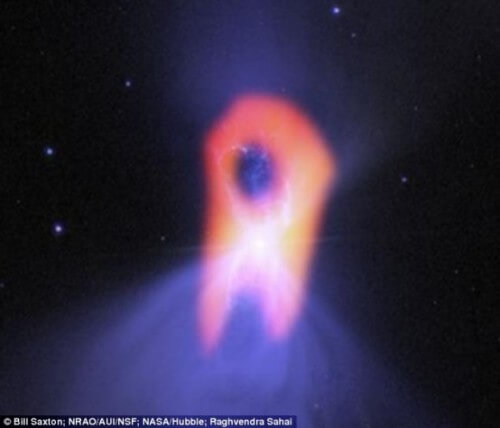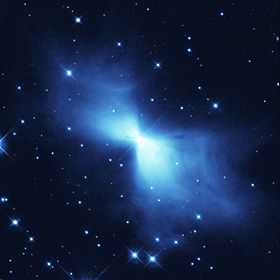Inside the Boomerang Nebula, a temperature of one degree above absolute zero prevails, less than the background temperature of the universe by 2.8 degrees Kelvin. The answer lies in the photoelectric effect for which (and not the theory of relativity) Einstein won the Nobel Prize

Where is the coldest place in the universe? Currently the answer is the Boomerang Nebula. The nebula, located within the Milky Way, 5,000 light-years away from us in the Centaur group, is a pre-planetary nebula whose temperature is about one degree Kelvin (the Kelvin scale starts at absolute zero and has no negative degrees) or minus 272 degrees Celsius.
This degree of heat makes the nebula even colder than the background temperature of space (which is known to originate from the Big Bang). The astronomers mobilized the power of the Atacama Large Millimeter/submillimeter Array (Atacama Large Millimeter/submillimeter Array) telescopes for the purpose of studying the nebula, in order to tell us about the cool properties of the object with the rare shape.
The Boomerang Nebula is different from all other bodies of its kind in every possible way. It is not yet a planetary nebula. Its source of light and fuel - the central star - is not hot enough to emit the amount of ultraviolet radiation that illuminates the entire structure. Currently, it is glowing thanks to the light of a companion star that illuminates all the dust grains around it.
When first observed in visible light with ground-based telescopes, the nebula appeared to be tilted to one side, causing the appearance that gave it its name. Follow-up observations by the Hubble Space Telescope have also revealed the structure of a watch glass. Now Alma's new observation tells us that what we saw in the Hubble image is only part of what's going on and that the double lobe seen in the older data is just the result of a trick of light, as reflected in the wavelengths of visible light.
"An extremely cold object is extremely intriguing, and we have learned a lot about its true nature with Alma's help," says Raghavendra Sahai, researcher and principal scientist at NASA's Jet Propulsion Laboratory in California, and the lead researcher on the article published in the Astrophysical Journal. "What looks like a double lobe or boomerang formation to ground-based telescopes is actually part of a much more extensive structure spreading rapidly through space."
What, then, makes Boomerang so cold? This is the outgoing flow. The central star expands at a crazy rate, which lowers the degree of heat in the process. An example of this can be seen in air conditioning systems that use expanding gas to create a cold core and when the air flows through it, or in this case - the inflatable shell of the star - the area around the core cools. The astronomers were able to determine how cold the gas in the nebula is by calculating the way it absorbs cosmic microwave radiation, which measures 2.8 degrees Kelvin.
When astronomers looked at this bone in 2003 with Hubble, they saw a classic example of the clock shape, Sahai says. "Many planetary nebulae show the double lobe structure which is the result of gas moving at high speed from the star. The gas jets pierce holes in the cloud of gas that surrounds the star, and which was ejected from it in an earlier period when it was a red giant.

However, a single millimeter wavelength telescope has not seen things like Hubble. The telescope saw an almost completely spherical configuration of material ejected from the star. According to the researchers, Alma's high resolution allowed researchers to determine why there is a difference in the shape seen at different wavelengths. The configuration of the double lobe was seen when they focused on the scattering of carbon monoxide molecules as they are seen in light waves in the millimeter range, but only in those moving into the nebula. The exterior is another story. The Alma telescope revealed a strained but relatively round cloud of cold gas. Moreover, the researchers also observed a thick corridor of millimeter-scale dust particles surrounding the star. This is why the outer cloud looks like a bow tie in visible light. These dust grains obscure some of the starlight, allowing only a faint hint of visible light to reach the far side of the cloud.
"This is important for understanding the way in which stars die and become planetary nebulae," Sahai says. "Using Alma allowed us the ability to literally shed new light on the dying phase of sun-like stars."
According to him, the answer to the question of why even though the edges of the nebula are heating up, its interior is still colder than the cosmic background radiation - is found in Einstein - the photoelectric effect.

24 תגובות
For miracles - that's right, referring to the observable universe. And regarding the fact that the colder place will be one degree less, you must understand that in such a case the place found in the article is several times higher in temperature, and this is really "serious".
Good night
Sabdarmish Yehuda
Yehuda
Could it be that they were looking for a colder place in a much larger radius, and this is the coldest place they found?
In the worst case - there is a more distant place, which is colder at less altitude. Is it really that serious?
And I don't think the universe is billions of light years in size - it may be much, much bigger than that. I assume you mean the observable universe, right?
ravine:
And if you haven't read the original in English, feel free to correct the distortion and read it
ravine:
I did not say that there is a plausible explanation in the article.
More than that - I said that what is written in the article does not correspond to the source.
Not that there is an explanation in the original, who knows what, but your demand for an explanation does not belong to the debate if there is a connection between the title and the content.
Ok.
So I'm ready for you to explain to me from the article how you connect the photoelectric effect with what the article says.
Or rather how what Einstein said explains the phenomenon they described!
ravine:
The end of the article is also part of the article and so is the subtitle.
Hi Michael.
I didn't read the article in English, but from a search in the article they presented here, the word Einstein appears once in everything they presented, and that's only at the end.
Philo:
right
ravine:
The point is that there is a connection and it is explained in the article in several places (search for the word Einstein and you will see).
Although the explanation is not a faithful translation of the researchers' words, that is another story.
Hi Michael.
I meant that there is no link between the title of the article and its content.
Not that Heisenberg** discovered the effect. In the same way, I could write down the coldest place in the universe and Shaul Tamrokim.
Einstein did not discover the photoelectric effect, he developed a law that explains it.
The effect was discovered by Heinrich Hertz.
To all my fans, I remind you: Here is what is written in the first paragraph of the article here in the knowledge:
"Where is the coldest place in the universe? Currently the answer is the Boomerang Nebula. The nebula, located within the Milky Way, 5,000 light-years away from us in the Centaur group, is a pre-planetary nebula whose temperature is about one degree Kelvin (the Kelvin scale starts at absolute zero and has no negative degrees) or minus 272 degrees Celsius." End quote.
So for those who don't know, 5000 light years away is our backyard. The universe is billions of light years in size. Tell me, isn't it clear to you that there are surely colder places in the universe? Why not write: Where is the coldest place in our surroundings? Defining this place even temporarily as the coldest in the universe is misleading.
Please respond gently.
Thanks
Sabdarmish Yehuda
There is actually a mistake in the citation chain.
In the article here - like In an article in Universe Today from which it was translated - it is noted that the extreme cold in the nebula is due to the photoelectric effect (which was discovered by Einstein and no one else - neither Eisenberg nor Heisenberg - to the attention of ravine).
In the original NRAO article They do not explain the cold in the heart of the nebula, but rather the warming of its edge by the aforementioned photoelectric effect:
The new research also indicated that the outer fringes of the nebula are beginning to warm, even though they are still slightly colder than the cosmic microwave background. This warming may be due to the photoelectric effect — an effect first proposed by Einstein in which light is absorbed by solid material, which then re-emits electrons.
It wasn't me who connected - the researcher did it.
There is no connection between the title and the content of the article!
Just as well, you could write down the connection between the coldest place in the universe and Eisenberg.
what is happening to you!!! This is not the first time you are not accurate...
I ask that you respect the stage - and do not write inaccurate headlines - this is not a news site looking for scoops...
Already in 2011 they discovered that this is a temperature of 1 degree Kelvin...
Yehuda
It's a shame that you respond without referring to the body of the article - in the second sentence it says "Where is the coldest place in the universe? Currently, the answer is the boomerang nebula." The author of the article, at least, has no problem with modesty...
Lesbadramish Yehuda
Matter cannot exist at less than minus 273 degrees (absolute zero).
What has changed since 2003?
I would build a supercomputer there, the cooling of the conductors is free 🙂
What was discovered, what was discovered, R.H. Discovered the Boomerang Nebula already two years ago.
https://www.hayadan.org.il/maby-neutrino-didnt-pass-speed-of-light-181011/comment-page-19/#comment-314912
It's ridiculous to say that the coldest place in the universe is actually in our backyard. Out of a hundred billion galaxies in the universe we were privileged to be the coldest place. A little modesty. Let's say we found a very cold place in our galaxy maybe the coldest in our galaxy but not the coldest in the universe.
good week
Sabdarmish Yehuda
Astronomy and astrophysics is nice, but there is too much of that on the site, and too little of other subjects in physics and other fields.
Sometimes these reports are clearly incomplete, like the one above (how exactly does the photoelectric effect explain the phenomenon of a temperature that is below the background temperature?), and thus they become completely marginal.